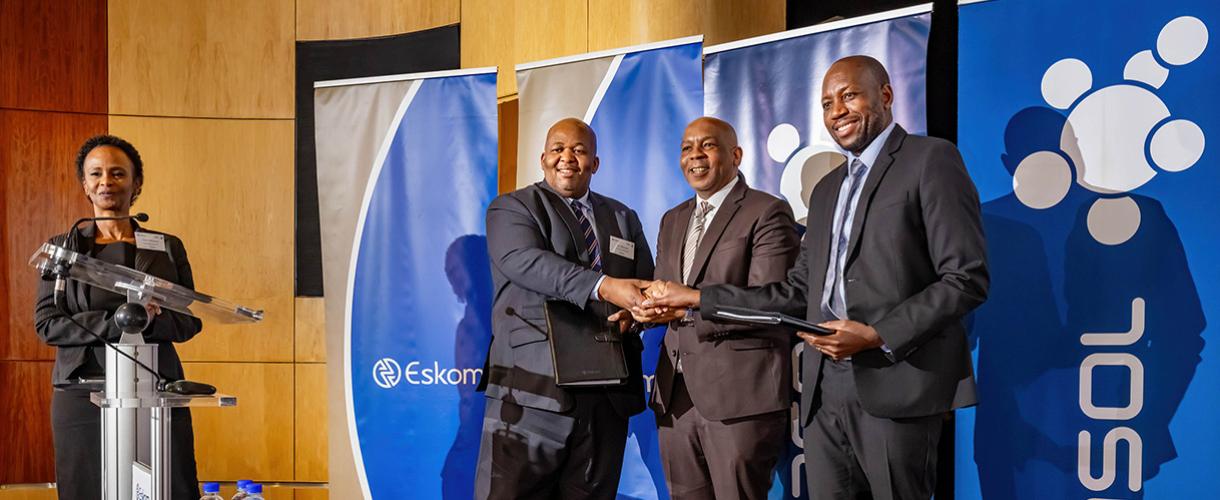As South Africa faces a looming gas-supply crisis, Sasol and Eskom are set to explore the future needs of liquefied natural gas (LNG), according to a memorandum of understanding.
The Industrial Gas Users Association Southern Africa (IGUA-SA), whose members employ thousands of people and make billions of rand for the domestic economy, has warned about the consequences should the security of gas supply be disrupted.
The power, industrial and transport sectors are predicted to be the most affected by South Africa’s gas-supply outlook.
Smoother transition
Sasol president and CEO Simon Baloyi said: “As a leading energy player in South Africa, we are excited to collaborate with Eskom to transform the regional energy landscape.”
Eskom Group CEO Dan Marokane explained that the power utility and Sasol had “… a great deal of experience as the two-largest users of coal in South Africa”.
Marokane continued “we felt by working together we could accelerate the climate change transition in a responsible way which sets the country up for the best economic, environmental and social outcomes and addresses the imminent gas-supply shortfall”.
Curbing coal
South Africa has committed to a just energy transition from a coal-based economy to cleaner sources of fuel, with timelines set for 2030 and an eventual net zero position in 2050.
About 90% of the country’s electricity is generated from coal, which contributes to South Africa being a high emitter of greenhouse gases.
As the two-largest coal users in the country, Sasol and Eskom have to find other resources with which to replace the fossil fuel. Although also a fossil fuel, gas is seen as a cleaner and cheaper alternative to coal.
Gas gamble
Sasol is the main provider of gas imported from Mozambique to major industrial users in Gauteng, Mpumalanga, the Free State and KwaZulu-Natal. From June 2026, Sasol is expected to cut gas supply to manufacturers and use the resource at its own operations.
Sasol’s move has triggered expectations of a looming gas-supply crisis in South Africa between 2026 and 2030 because there is, for now, a shortage of viable alternatives to plug the hole that will be left by the company.
The South African government is in a race against time to prevent a gas cliff, the worst-case scenario when Sasol switches off supply of the resource from the Lilly gas pipeline and decommissions the Middelburg gas pipeline.
Saving KwaZulu-Natal
In the Gas Master Plan published earlier in 2024, the government points out that “… most of the natural gas consumed in … [South Africa] is imported piped gas from Mozambique.”
The government also highlights the fact that: “Methane-rich gas dedicated to demand in KwaZulu-Natal will stop from 2027 and be used for Sasol’s own use.”
The problem with that is “Sasol … [methane-rich gas] is currently the only dedicated supplier to the eastern coast and flows from Secunda through the Lilly pipeline to KwaZulu-Natal.”
Liquefied natural gas to the rescue?
In the Gas Master Plan the government proposes that “… [t]o mitigate against gas-supply shortages between 2026 and 2030, it is quite urgent to engage within the region to establish enablers that could unlock additional regional supply potential.”
Possible replacement sources include LNG imports, which need infrastructure.
The government has identified Richards Bay in KwaZulu-Natal; Ngqura, also known as Coega, in the Eastern Cape; and Saldanha Bay in the Western Cape as sites where LNG port terminals can be developed.
Industry warning
In August 2024, Transnet Pipelines issued a call for expressions of interest to repurpose the Lilly gas pipeline from methane-rich gas use to regasified LNG.
In the association’s 2024 annual report, IGUA-SA chairperson Thomas Shaw said Industrial gas users directly employed an estimated 70,000 people and contributed between R300 to R500 billion a year to the economy.
“A cessation of has supply will result in multiple plant closures and a significant reduction in manufacturing output across KwaZulu-Natal, Gauteng and Mpumalanga,” Shaw warned.
How should South Africa prevent a gas-supply cliff?
Let us know by clicking on the comment tab below this article or by emailing info@thesouthafrican.com or sending a WhatsApp to 060 011 021 1
You can also follow @TheSAnews on X and The South African on Facebook for the latest news.
